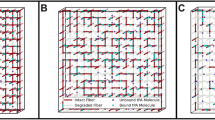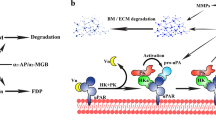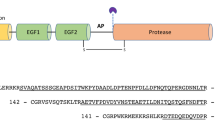Abstract
THE proteolytic enzyme system in blood that is predominantly responsible for removal of fibrin deposits, is called the fibrinolytic system. This system consists of three main components: the proenzyme plasminogen, which can be activated by limited proteolysis to the proteolytic enzyme plasmin; plasminogen activators, the most important of which probably originates in the endothelial cells; and inhibitors, which can rapidly neutralise plasmin or interfere with the activation of plasminogen. The proteolytic enzyme plasmin has a broad specificity, which is not very different from that of trypsin. However, in vivo the main target of plasmin is fibrin. Three hypotheses have been put forward to explain this specificity. Alkjaersig et al.1 have suggested that plasminogen is adsorbed to polymerising fibrin and converted to active enzyme by activators which diffuse into the thrombus. Plasmin would then exert its action in an environment relatively free of inhibitors. Ambrus and Markus2 have proposed that plasmin–inhibitor complexes formed in the circulation dissociate in the presence of fibrin, because plasmin has a greater affinity for fibrin than for its inhibitors. Chesterman et al.3 suggested that the activators bind selectively to fibrin and transform plasminogen, which diffuses into the thrombus, to plasmin. During the past few years specific interactions at the molecular level have been demonstrated between the different components of the fibrinolytic system. These findings now enable us to formulate a molecular model for the regulation of fibrinolysis in vivo.
This is a preview of subscription content, access via your institution
Access options
Subscribe to this journal
Receive 51 print issues and online access
$199.00 per year
only $3.90 per issue
Buy this article
- Purchase on Springer Link
- Instant access to full article PDF
Prices may be subject to local taxes which are calculated during checkout
Similar content being viewed by others
References
Alkjaersig, N., Fletcher, A. P. & Sherry, S. J. clin. Invest. 38, 1086–1095 (1959).
Ambrus, C. M. & Markus, G. Am. J. Physiol. 199, 491–494 (1960).
Chesterman, C. N., Allington, M. J. & Sharp, A. A. Nature new Biol. 238, 15–17 (1972).
Thorsen, S. Biochim. biophys. Acta 393, 55–65 (1975).
Wiman, B. & Wallén, P. Thromb. Res. 10, 213–222 (1977).
Rákóczi, I., Wiman, B. & Collen, D. Biochim. biophys. Acta 540, 295–300 (1978).
Iwamoto, M. Thromb. Diath. Haemorrh. 33, 573–585 (1975).
Sottrup-Jensen, L., Claeys, H., Zajdel, M., Petersen, T. E. & Magnusson, S. in Progress in Chemical Fibrinolysis and Thrombolysis (eds Davidson, J. F., Rowan, R. M., Samama, M. M. & Desnoyers, P. C.) (Raven, New York, in the press).
Wiman, B. & Wallén, P. Eur. J. Biochem. 50, 489–494 (1975).
Thorsen, S., Glas-Greenwalt, P. & Astrup, T. Thromb. Diath. Haemorrh. 28, 65–74 (1972).
Wallén, P. in Thrombosis and Urokinase (eds Paoletti, R. & Sherry, S.) 91–102 (Academic, London, 1977).
Pepper, D. S. & Allen, R. Presented at the 3rd Woudschoten Conference on Screening Methods for Detection of a Tendency to Thrombosis, Utrecht The Netherlands, 26–29 October (1977).
Collen, D. Eur. J. Biochem. 69, 209–216 (1976).
Moroi, M. & Aoki, N. J. biol. Chem. 251, 5956–5965 (1976).
Müllertz, S. & Clemmensen, I. Biochem. J. 159, 545–553 (1976).
Wiman, B. & Collen, D. Eur. J. Biochem. 78, 19–26 (1977).
Moroi, M. & Aoki, N. Thromb Res. 10, 851–856 (1977).
Christensen, U. & Clemmensen, I. Biochem. J. 163, 389–391 (1977).
Wiman, B. & Collen, D. Eur. J. Biochem 84, 573–578 (1978).
Author information
Authors and Affiliations
Rights and permissions
About this article
Cite this article
WIMAN, B., COLLEN, D. Molecular mechanism of physiological fibrinolysis. Nature 272, 549–550 (1978). https://doi.org/10.1038/272549a0
Received:
Accepted:
Issue Date:
DOI: https://doi.org/10.1038/272549a0
This article is cited by
-
Engineered Molecular Therapeutics Targeting Fibrin and the Coagulation System: a Biophysical Perspective
Biophysical Reviews (2022)
-
Purification of serine protease from polychaeta, Lumbrineris nipponica, and assessment of its fibrinolytic activity
In Vitro Cellular & Developmental Biology - Animal (2017)
-
Identification of a new serine protease from polychaeta, Marphysa sanguinea, for its thrombolytic and anticoagulant activity
Korean Journal of Chemical Engineering (2017)
-
Prostate Cancer Cell Surface-Associated Keratin 8 and Its Implications for Enhanced Plasmin Activity
The Protein Journal (2012)
-
Neue Überlegungen zu Entzündung und Gerinnung
Der Anaesthesist (2007)
Comments
By submitting a comment you agree to abide by our Terms and Community Guidelines. If you find something abusive or that does not comply with our terms or guidelines please flag it as inappropriate.



